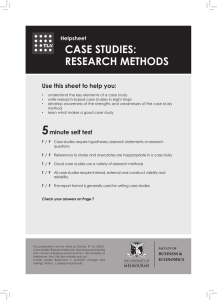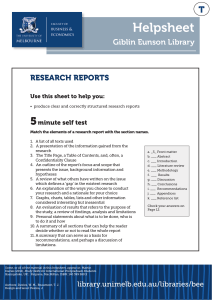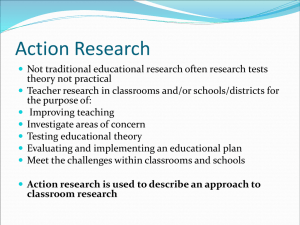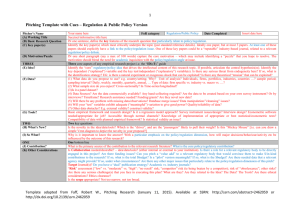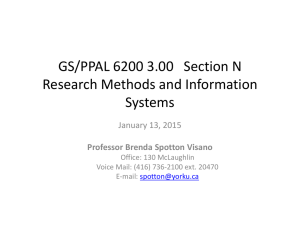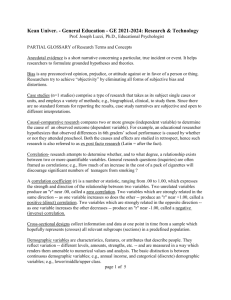Case Studies: Research Methods
advertisement
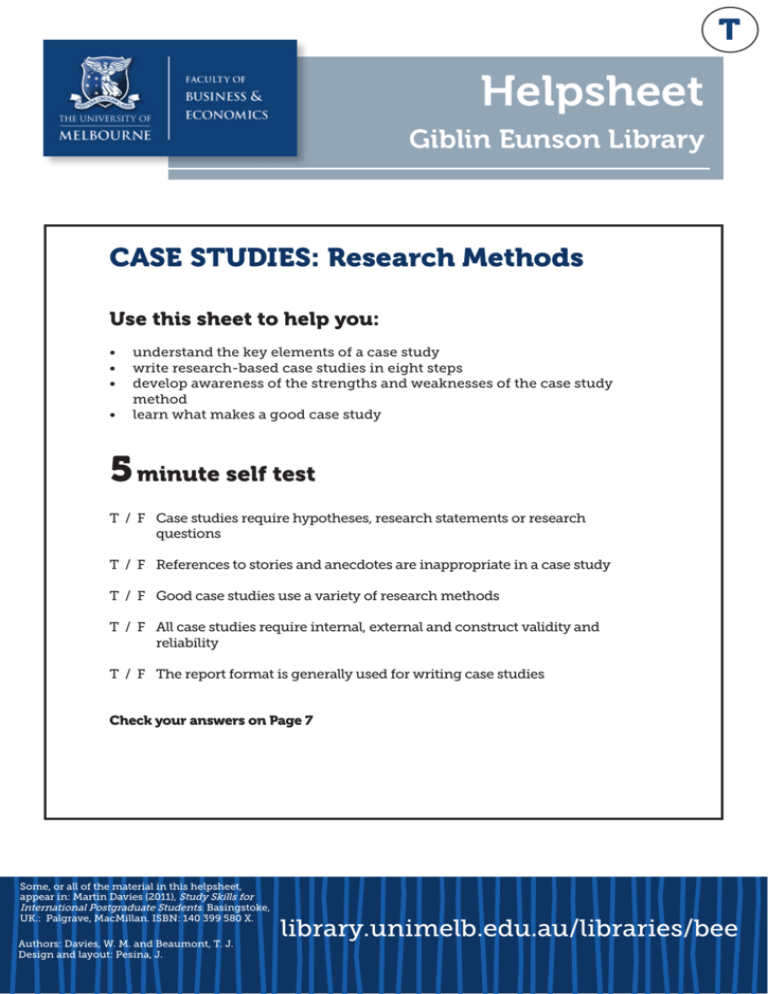
T Helpsheet Giblin Eunson Library CASE STUDIES: Research Methods Use this sheet to help you: • understand the key elements of a case study • write research-based case studies in eight steps • develop awareness of the strengths and weaknesses of the case study method • learn what makes a good case study 5 minute self test T / F Case studies require hypotheses, research statements or research questions T / F References to stories and anecdotes are inappropriate in a case study T / F Good case studies use a variety of research methods T / F All case studies require internal, external and construct validity and reliability T / F The report format is generally used for writing case studies Check your answers on Page 7 Some, or all of the material in this helpsheet, appear in: Martin Davies (2011), Study Skills for International Postgraduate Students. Basingstoke, UK.: Palgrave, MacMillan. ISBN: 140 399 580 X. Authors: Davies, W. M. and Beaumont, T. J. Design and layout: Pesina, J. library.unimelb.edu.au/libraries/bee CASE STUDIES: Research Methods T Research-based vs. classroom based case studies The term “case study” can refer to different tasks. As a student, you may be asked to conduct a case study of a business situation that involves use of research methods. For example, you may be asked to investigate the performance of a small business in a particular industry that interests you. This is an entirely different task from that of analysing a case which is presented to you by your lecturer for analysis with reference to your course book and wider texts. This Helpsheet covers the former. If you are asked to do the latter, see Study and Research Helpsheet Case Studies1 and Case Studies 2. What is a case study? Below are some useful definitions put forward by two dictionaries: 1. A detailed analysis of a person or group, especially as a model of medical, psychiatric, psychological, or social phenomena. 2. a. A detailed intensive study of a unit, such as a corporation or a corporate division that stresses factors contributing to its success or failure. b. An exemplary or cautionary model; an instructive example: (The American Heritage Dictionary of the English Language, 2000, as cited in The Free Dictionary, 2008) 3. An analysis of a group or person in order to make generalizations about a larger group or society as a whole (Collins Essential English Dictionary, 2006, as cited in The Free Dictionary, 2008) What’s unique about a case study? It is useful to contrast case study methodology with the two other main forms of research methodology used in the Faculty of Economics and Commerce: • Empirical or experimental research-based projects. These include surveys, statistics, questionnaires or fieldwork. Page 1 library.unimelb.edu.au/libraries/bee CASE STUDIES: Research Methods T • Theoretical projects. These tend to look mainly at conceptual issues. • Case studies. These involve analysis of real world problems of which one has experience or is able to observe. All of these forms of investigation have advantages and disadvantages. For example, empirical work requires enormous effort in terms of question design and fieldwork. Results of empirical work may be inconclusive, so re-testing is sometimes required. However empirical work is useful because it is real life data that can be measured. Most empirical studies are “large-n” studies (involving many participants), so the results can be shown to be statistically significant. Conceptual research, on the other hand, can be a solitary experience. However, it has the advantage of being easier to carry out as there is no need to plan and set up empirical tests. Only articles, books and time are needed. Strengths and weaknesses of the case study method Case study method has the strengths and weaknesses of both forms of inquiry. Weaknesses Case studies involve analysis of small data sets, such as one or two companies, that may lead the researcher to gain some insights about trends in relevant industries. For example, a case study about the Mitsubishi car company might be used to generalise about similar companies in the automobile industry. The data is “real life” in the sense that a company or companies have been chosen as the source of the data. However, the studies involve “small-n” data and therefore conventional empirical techniques cannot be used, or where they are used, they may have limited application as there may not be enough data to meet requirements for statistical significance. Strengths The case study method involves detailed, holistic investigation (for example, all aspects of a company) and can utilise a range of different measurement techniques (the case study researcher is not limited to any one methodological tool). Data can be collected over a period of time, and it is contextual (relative to a certain industry). The histories and stories that can be told about the company are also something that can be assessed and documented—not just empirical data, for example, stories and anecdotes about how the company interacts with the marketplace can be used. Conducting a case study in eight steps Step 1: Establish the broad case to investigate Page 2 library.unimelb.edu.au/libraries/bee CASE STUDIES: Research Methods T Your lecturer may give you a specific case to investigate. If on the other hand, you have to choose one, first ask yourself: • • • • Can I gain access to the company? (Is it local or offshore? Is the data available or subject to commercial confidence?) Is there enough published information on the company? Is too much information already available? Will I be able to conduct the study in the time I have available? Step 2: Establish the research question(s) After you establish the case you want to investigate, you need a question or series of questions to answer. Note that most research questions begin with: how, why, what or can, and they are clearly formulated, narrow and researchable. You can also use a research statement to guide your investigation. Research statements can be conditional or non-conditional, directional or non-directional or expressed as a null hypothesis. See the Study and Research Helpsheet: Research Essentials and The Research Process for further assistance. Below is an example of a testable research statement: There is a difference between the work ethic values of Australian and Asian employees working in the Mitsubishi Car Company in Adelaide and Japan. Once you have a hypothesis or research question/statement, you need to do an extensive literature review to find what others have done in this area. See Study and Research Helpsheet: Literature Reviews). Step 3: Select the precise case(s) to be used You then need to choose a precise case (or cases) to study. A single case might be, for example, the operation of a certain private hospital. A multiple case might involve looking at several different companies operating in the wine industry. When using multiple cases, you need to treat each case as a single case. You would best devote a chapter or section of your study to each case. The conclusions from each part can then be used as information contributing to the whole study, but each case should remain separate in your treatment. It is useful to select cases that: • • • • represent a variety of geographic regions represent a variety of size parameters (i.e., big and small companies with a large and small client base) represent different market segments use different raw materials, etc. Page 3 library.unimelb.edu.au/libraries/bee CASE STUDIES: Research Methods T In other words, choose cases that are unique in different ways. Step 4: Determine data gathering and analysis techniques Good case studies use a number of different research tools to increase validity. For example, you can use both qualitative and qualitative approaches and different data collection instruments (surveys, interviews, documentation review, artefact collection). You should aim to “triangulate” your research instruments or techniques so they provide different views of the case. This avoids the problem of observer bias, i.e., your choice of instrument measuring what you want to see and not what is really there. It is best to use multiple cases in your study as this provides more evidence. If, however, you are analysing a single case study, make sure that you look at different levels of analysis, for example, a firm which is part of an industry and the industry itself (e.g., Mitsubishi in Australia and the car industry at large). This type of case study increases the complexity and amount of data that can be evaluated. Remember that your aim should be to collect data from many different sources so that light will be shed on your research question from many angles. When researching, you must ensure construct validity, internal validity, external validity, and reliability. Construct validity means selecting the most appropriate measurement tool for the concepts being studied. Does your tool really measure what you want to assess? Internal validity is another term for using different methodological tools to “triangulate” the data. What other methods can you use to check for the same phenomenon? External validity refers to how well the data can be applied beyond the circumstances of the case to more general situations. Can you apply your data across the industry and to others? Reliability means the extent to which the results can be repeated in ways that yield the same results. That is, the extent to which the results are accurate and stable. Are you confident that your study can be repeated by others and the results will be the same? Page 4 library.unimelb.edu.au/libraries/bee CASE STUDIES: Research Methods T Step 5: Prepare to collect the data You need a method of coding, categorising and sorting your data. It is no good conducting your study and then finding that all the good data was not recorded properly or that you missed opportunities. You might consider establishing any or all of the following: • • • • • • Databases designed to codify data Protocols for interviews and surveys Pilot studies that capture the concepts and data needed Formats for narrative reporting Field notes Procedures for tape or video recordings When carrying out the study, be flexible in real-life situations and have contingency plans for things that may go wrong. Specifically: • • • • • Anticipate key events and problems Have a plan for unexpected changes, delayed appointments, lack of office space, unavailability of staff, etc. Be open to contrary findings and unexpected events or interview responses Approach people who feel threatened or unsure about the case study in a delicate manner Be prepared to revise the research design. Step 6: Collect the data Several points need to be kept in mind when collecting data: • • • • • • • Evidence must be collected systematically. While the case study methodology is very flexible, it must be clear how the data from various sources contribute to the overall aims of the study. You should not collect data randomly. There needs to be a purpose for collecting certain data. Refine your research question/statement if necessary. Data must be stored in formats that can be referenced so that the patterns of information are clear. Researchers should be able to see causal factors associated with the information collected (How is X related to Y?) If changes need to be made to the data collection procedure, these changes need to be recorded and documented. You need to be able to record anecdotes, comments and illustrations/examples easily—these might turn out to be vital pieces of qualitative information. Notes should be kept recording the thoughts you have about the evolving case study (e.g., in a case diary). Page 5 library.unimelb.edu.au/libraries/bee CASE STUDIES: Research Methods T Step 7: Analyse the data In case study research, data is used to find relationships between the object of study and the research questions posed. A few pointers about doing this follow: • • • • • • • One can quickly get lost in a web of complex data unless you have a clear research objective. You should aim to seek data that answers this objective from as many different sources as possible. Don’t try to establish thirty different things: establish one thing well with data from different areas that confirm it. Good researchers cross-check the facts and discrepancies their data. They also tabulate information so that it can be checked easily. Focus interviews may be needed to re-confirm existing data. Flow charts or other displays, and tabulating frequency of events are a good way of recording and analysing information. Quantitative data can be used to corroborate and support the qualitative data obtained and vice-versa. Multiple investigators can assist in seeing the patterns in the data. This can ensure confidence in the data. If there are discrepancies in how the data is viewed then the researchers need to investigate again. You should also investigate across case studies (from one company to another). Don’t just settle on one example from one case. Step 8: Prepare the report The report format is generally followed in writing up case studies (see Study and Research Helpsheet: Research Reports). However, this format can be modified as appropriate. • • • • Qualitative data: stories, anecdotes, quotations, interview transcripts, artefacts, recordings, etc. are placed in the Results section along with empirical data. Where possible, empirical evaluation techniques are used. The standard empirical report style is usually modified to make it clear how the data from different sources answer and/or illuminate the research question(s). Generally, the writer refers back to the research questions(s) with quotations or other qualitative/quantitative evidence collected. The report also includes evidence from published literature that confirms and disconfirms the data collected. This is generally placed in the Discussion section, and analysed carefully. Page 6 library.unimelb.edu.au/libraries/bee CASE STUDIES: Research Methods T Answers 5 minute self test T / F Case studies require hypotheses, research statements or research questions T / F References to stories and anecdotes are inappropriate in a case study T / F Good case studies use a variety of research methods T / F All case studies require internal, external and construct validity and reliability T / F The report format is generally used for writing case studies References Soy, S. K. (2003). The Case Study as a Research Method. Accessed 10/10/03 from http://www.gslis.utexas.edu/~ssoy/usesusers/l391d1b.htm Seperich, G.J, M.J. Woolverton, J. G. Beierlein and D. E. Hahn, (eds.) (1996). Cases in Agribusiness Management, Gorsuch Scarisbrick, Scottsdale, AZ The Free Dictionary by Farlex (2008). Case Study. Accessed 31/10/2008, from http:// www.thefreedictionary.com/case+study Yin, R. K. (1984). Case Study Research: Design and Methods. Newbury Park, CA: Sage. Page 7 library.unimelb.edu.au/libraries/bee
